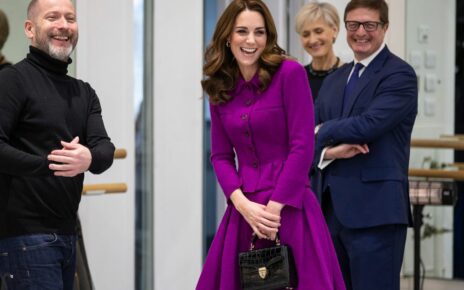It’s been really quite marvellous to read the retrospectives to The Late Show, 30 years on from its Saturday night debut on ABC TV. Is it really that long ago?
No, not the David Letterman/Stephen Colbert Late Show, but uproarious anything-goes ensemble of Mick Martin, Tony Molloy, Jane Kennedy, Tom Gleisner, Santo Cilauro, Jason Stephens, and Judith Lucy, who between 1992 and 1993 put on a show that to this day is part of the lexicon for a certain generation of Australians (ie, mine).
Santo Cilauro and Rob Sitch as sports presenters Graham and The Colonel on The Late Show.Credit:ABC
It aired in front of a studio audience, 40 episodes over two series, on Saturday nights at 10pm.
But it was through VHS tapes – recorded off the telly and swapped, or “The Best Bits” volumes 1 and 2 rented from the video store – that we memorised the lines of dialogue now seared into the comedic consciousness.
What a mad cap ensemble it was.
The opener from Mick and Tony, who went on to host their own wildly successful Martin-Molloy radio show; Tommy G at the news desk recapping the week’s headlines, usually featuring a “live via satellite” interview with Sitch impersonating as some political leader or celebrity; the prerecorded bits like “Shitscared” or “Charlie the Wonder Dog” featuring Bud Tingwell and the “Pissweak Kids”.
There were the street walks with Martin and Molloy before Sam Newman did it on The Footy Show, and recurring characters like the sportscasters Graham and the Colonel, with their Richie Benaud wigs and green ABC blazers.
Episodes closed with musical acts, the punchline being that Mick was responsible for booking the artist but could never get the names quite straight, thus legendary Channel Nine and Copperart voiceover man Pete Smith sang “Dude Looks Like a Lady” rather than Aerosmith; and former Victorian Premier Joan Kirner did “I Love Rock ‘n’ Roll” rather than Joan Jett.
Much of The Late Show survives now on YouTube, some of it would never be permitted on television today.
Sitch did perhaps the first and definitive impression of Bruce McAvaney, as well as a memorable Jeff Kennett (“My car’s the car with the flag on the bonnet”) and John Hewson (“I challenge the prime minister Paul Keating … Paul Keating…”)
But there was also blackface renditions of Imran Khan (“Like a Tiger”), Desmond Tutu (“WHAT WE NEED!”) and Yasser Arafat that would not pass muster with modern standards.
In one searingly funny bit after the Bisho Massacre in South Africa, Sitch played the part of president F.W. de Klerk replete with bad accent, interviewed by Gleisner on the desk:
Sitch: Listen here, you have to see this from the soldiers’ point of view. There’s a large group of demonstrators demonstrating towards them, what would you do?
Gleisner: I guess I’d let them march past.
Sitch: You’d shoot them, wouldn’t you!
Gleisner: No I said I’d let them march past.
Sitch: Well that’s easy to say in hindsight. But the soldiers were provoked.
Gleisner: In what way?
Sitch: The crowds were prancing and chanting. They were singing Sting songs! There is only so much you can take of that.
Gleisner: Well perhaps an obvious question, why didn’t they fire warning shots?
Sitch: They did.
Gleisner: What, over their heads?
Sitch: Over their kneecaps! You cannot get a much stronger warning shot than that!
It finishes with Sitch in character asking, “Do you want to know what the F.W. stands for?” amid uproarious laughter from the live audience.
The one 90-second sketch bred a half-dozen instantly quotable lines (“You twist it … you put facts in the story!”) that still get a run three decades on, but it also contains racial slurs, meant to parody the racism of the white-minority ruling regime that De Klerk eventually negotiated to dismantle.
Those words would disqualify the sketch from television today and result in instant cancellation.
While politicians and politics were sometimes the punchline, The Late Show was not overtly political like much modern comedy seems inescapably to be.
If anything, its signature vibe was daggy, not mean-spirited, and prepared to tackle anything if there might be a laugh in it.
The Oz Brothers, Sitch and Cilauro with mullet wigs, moustaches and pillow jammed under their sweaters, worshipped (literally) David Boon, declared “This country is stuffed!” but also, “It’s the greatest country in the world, though.”
Consider the suburban dinner party with the bore (again played by Sitch) who could not resist one-upping whatever other guests had to say, like the woman played by Kennedy who proclaims: “I think giving birth is just the most wonderful experience ever.”
Replies Sitch’s one-upper: “You obviously haven’t stood at the summit of Mt Everest.”
And not everything worked. The line that became the show’s signature, “Champagne sketch comedy”, was almost a sly acknowledgement of a sketch or setup that bombed on arrival.
There’s not many Aussie shows that retain such cachet three decades on after just two seasons.
And the subsequent output of the Late Show crew – through the Working Dog production house and other ventures – truly has been champagne.
Frontline, The Panel, The Castle, The Dish, Russell Coight, Warwick Todd, The Hollowmen and Utopia, among other projects.
Arguably no group of artists has had as profound collective impact on modern Australia’s sense of humour and sensibilities.
Follow WAtoday on Instagram, LinkedIn, Facebook and Twitter for handpicked selections of the day’s biggest local, national and international news.
Most Viewed in Culture
From our partners
Source: Read Full Article


